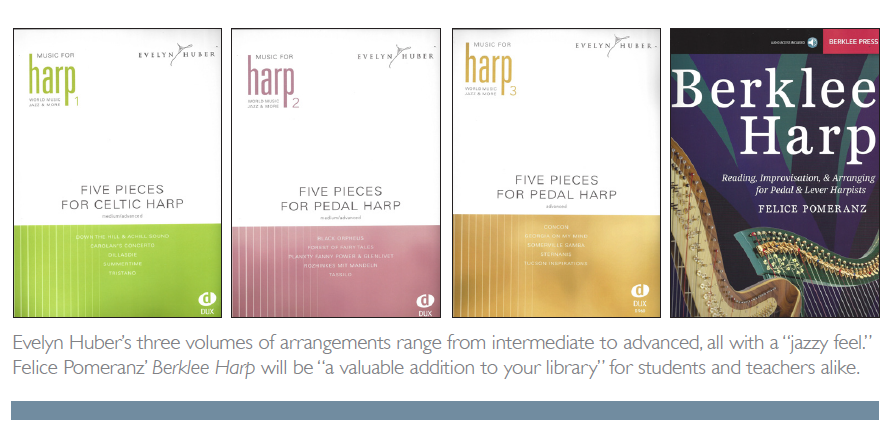
German harpist Evelyn Huber has released three new books of arrangements, published by DUX (www.dux-verlag.de).
The first volume is Five Pieces for Celtic Harp for the intermediate to advanced player. It contains a variety of music, but all with a jazzy feel.
“Tristano” is a medieval melody and most harpists are familiar with the well-known “Carolan’s Concerto.” Gershwin’s “Summertime” is an adaptation of an arrangement by Deborah Henson-Conant and Asita Hamidi. “Dillasdie” is an original composition by Huber. The final entry is a combination of a traditional Irish melody, “Down the Hill,” followed by Huber’s original, “Achill Sound.” There are no lever changes in any piece.
The second volume is Five Pieces for Pedal Harp for the intermediate to advanced player.
“Tassilo” is a fairly short and easy original tune with a few pedal slides. Luiz Bonfa’s classic bossa nova, “Black Orpheus,” features a slap bass in this passionate interpretation. There is an error in the pedal marking in measure 104 where the B-flat should be a B-natural.
“Rozhinkes Mit Mandeln” is a Jewish lullaby. Dampened notes in the left hand serve both as the melody and accompaniment. O’Carolan’s “Planxty Fanny Power” is fairly short and transitions to “Glenlivet,” co-arranged with Kim Robertson. The pedal marking changing the G-sharp in measure 131 back to natural is missing. An original tune, “Forest of Fairy Tales” completes this volume. Chord symbols are included only in the improvisation section of each piece except this last one.
The third and final volume is Five Pieces for Pedal Harp for the advanced player. Except for one piece, these are all original compositions by Huber. If you like jazz, this is the best of the three volumes, although more difficult.
“Somerville Samba” is an energetic piece inspired by the “grande dame of jazz harp,” Deborah Henson-Conant.
The composer describes “Sternanis Lied” (Song) and “Tanz” (Dance) as an experiment, “as if a wind from the Far East got caught in the strings.” You can hear the Asian influence. The enharmonic doubling of notes and use of harmonics hypnotically draws you into the song. The dance (“Tanz”) is quite fast, and at the end, the song (“Lied”) returns and ends with delicate harmonics.
Hoagy Carmichael’s gorgeous ballad “Georgia on My Mind” is sultry in Huber’s hands. Muffles, scale glisses, single and double pedal slides, and lush harmonies combine to create a very captivating arrangement. “ConCon” is an ode to Huber’s son, Constantin. It is a spirited and likeable melody.
Studying jazz harp with Carrol McLaughlin motivated Huber to write “Tucson Inspirations.” It’s a challenging, upbeat, and delightful tune. There are lots of pedal changes and a few errors or omissions in the pedal markings. The E-flat in measure 20 needs to be changed back to natural in measure 21. The B-natural at approximately the third beat in measures 31 and 48 should be a B-flat.
Pedal changes are written in the middle of the staff where they aren’t likely to be missed. The accidental signs are very small and a little difficult to see, but all the rest of the typesetting is easy to read. All three volumes include a dictionary of harmony in the back. There is a brief explanation of major, minor, suspended, half-diminished, and diminished chords, as well as major and minor triads with major and minor sevenths. There is also a glossary of special terms and features, which includes photos of the hands executing the techniques. Each book also has some beautiful photography of some of the subjects of the music or of Huber in various settings, including one of her perched with a pedal harp on the back of a camel!
Many of the selections from these books can be heard on Huber’s various recordings (with some variation), as well as on YouTube. Take a moment to listen and see which ones (if not all of them) appeal to you!
Huber’s brief discussion of chords is helpful, but for a more thorough exploration of harmony and much more, “Berklee Harp” by Felice Pomeranz is an excellent new resource. Published by Berklee Press, this phenomenal reference book contains 14 jam-packed chapters of useful information for both pedal and lever players.
Pomeranz starts out explaining basic information such as major and minor triads and inversions, and goes into I-IV-V-I progressions in all keys. You’ll want to sit at the harp to go through all the samples in this workbook which include playing the chords as arpeggios in parallel and contrary motion.
The book will introduce you to transposing, diminished and augmented chords, various rhythms, playing the blues and the bossa nova, modulation, and additional tensions. There are exercises for you to test your understanding of the material with an answer key in the back of the book.
There are also 76 audio samples you can listen to online by entering a code found in the front of the book. Pomeranz offers several of her original compositions to illustrate the concepts presented and you get to play some of them with other instrumentalists to practice playing in a trio or quartet. It’s a wonderful opportunity to learn to comp, solo, and improvise.
You won’t read through the 100 or so pages of text in one sitting. In fact, it may take many hours of study to get comfortable or memorize the chords and progressions. Pomeranz suggests adding a new skill each day.
A prerequisite of basic theory is helpful and some readers will still need the guidance of a knowledgeable teacher, but the information is presented in a logical, progressive fashion. Whether you are a teacher or a student, this book will be a valuable addition to your library. •






